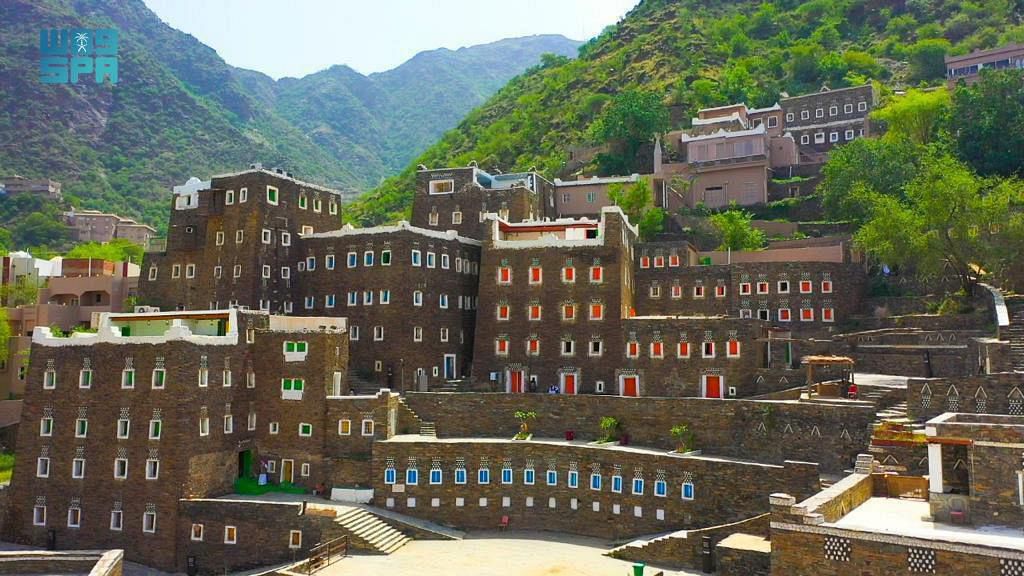
LAYNAH/MAKKAH: Desert tourists are heading to Saudi Arabia’s historic Laynah village as the first edition of the Zubaida Trail Winter Festival attracts visitors from the region and beyond with the promise of everything from poetry readings to rare wildlife sightings.
The nine-week festival, which will continue until Feb. 26, 2022, promises a seasonal escape and the chance to enjoy winter activities, as well as glimpse one of the more than 60 animal species in the region, including the Arabian bustard, Arabian wolf and spiny-tailed lizard.
More than 120 plant species, including acacia and sidr trees, and rare shrubs, such as awsaj, arfaj and ramth, can also be found in the area.
Ayn Zubaida (Zubaida Springs) in Makkah. (Supplied)
The festival is organized by the Imam Turki bin Abdullah Royal Reserve Development Authority, which is known for launching a wide range of environmental initiatives.
“The festival has become a great escape for locals and visitors to the area because of its appealing winter atmosphere. The festival’s numerous events are ideal for families, young people, the elderly and children, ” said Menahi Mite’eb, editor-in-chief of Rafha Today, an electronic-based newspaper.
Moneef Ali, who lives in Aewe, about 30 kilometers from Laynah, has taken his family to the festival twice in recent weeks to enjoy the winter activities, as well as a break from PlayStation and VR games.
Ali said that he hoped to see the King Abdul Aziz Historical Palace and the vintage cars on display.
“This is the best time to go to the festival,” he said.
Crafts, food and drinks made by productive families attracted a large crowd of visitors who came to buy gifts for their loved ones and friends.
Over 60 young male and female volunteers are overseeing festival activities, including folklore segments, poetry nights, a museum and interactive games.
Abdulsalam Alowaijan said that volunteering is helping reshape his skills and will assist him in his future career.
Ayn Zubaida (Zubaida Springs) in Makkah. (Supplied)
The 18-year-old said that he is learning how to deal with people and understand their needs.
Visitors to the festival can visit the historic palace, wells, routes and monuments via designated trips and paths.
“The festival has revitalized the region’s economy and tourism,” Mite’eb said, adding that the poetry nights have drawn large numbers of people because of well-known poets taking part.
Laynah, one of the oldest settlements in the Arabian Peninsula, is situated on a route that was part of the Zubaida Trail used by Iraqi pilgrims during their Hajj and Umrah journeys to Makkah.
The area is known for the abundance of waters and wells, as well as its historical significance. Historic sites include King Abdul Aziz Palace, built in 1935, and the old market or “souk,” named after Iraqi merchants who used to exchange goods with the people of Najd.
The Zubaida Trail, or Al-Kufi pilgrimage route, runs from Kufa in Iraq to Makkah, passing through the north and center of the Kingdom.
It was named after Zubaida bin Jafar, wife of the Abbasid Caliph Harun Al-Rashid, in recognition of her charitable work, in addition to the number of stops she ordered to be established along the trail.
The trail functioned as a trade route in the pre-Islamic era, but its importance later increased and it flourished during the time of the early caliphate. The trail reached its peak during the Abbasid era between 750 and 1258 when it became a properly paved road.
Stations, wells, pools and dams were established, and houses built along the trail leading to Makkah. Twenty-seven major stations have been identified, including Al-Sheihiyat, Al-Jumaima, Faid, Al-Rabadha, That-Erq and Khuraba.
With the increase in the number of Muslims in the early Islamic time, especially the Umayyad and Abbasid eras, the lack of water sources in Makkah and the holy sites posing a serious problem for residents, especially during the Hajj season.
Visitors to the festival can visit King Abdul Aziz Historical Palace, wells, routes, and historical monuments via designated trips and paths. (SPA)
Dr. Mohammed Al-Sharif, a researcher into the history of the Makkah region, said that water scarcity was a problem, and a challenge for the people of Makkah and the pilgrims. At times, the price of Al-Badrah (a small bagpipe) was 10 dirhams or more, a very high price for most pilgrims.
When Zubaida learned about the water shortages the pilgrims had been facing, she ordered the digging of Ayn Zubaida, or Zubaida springs, in 810. This helped to ease water scarcity at the holy sites and surrounding villages for hundreds of years.
Al-Sharif told Arab News that Zubaida commissioned and paid for construction of Ayn Zubaida. She called on architects and engineers to address the problem.
The springs are an enduring symbol of the golden era of Arab culture, Al-Sharif said.
“It constituted a great example of Islamic heritage and a masterpiece of engineering that embodies the greatness of the people who lived in the vicinity of the two holy mosques. It is a testament to their determination to adapt to the difficult terrain and to build a great human civilization,” he said.












